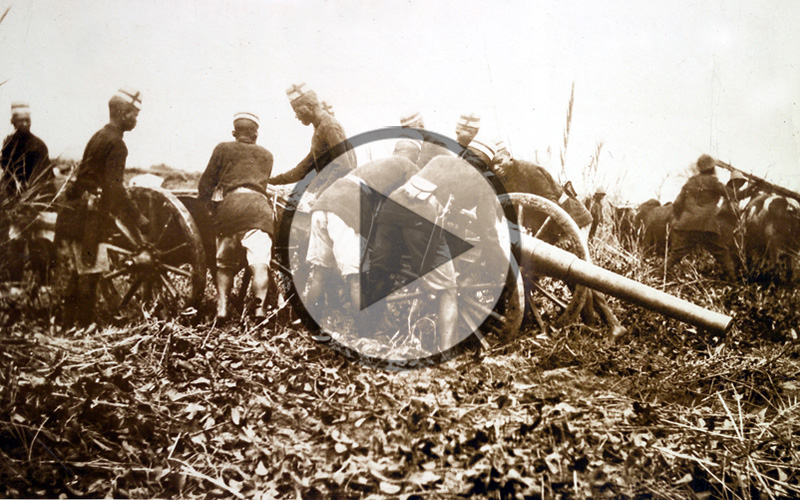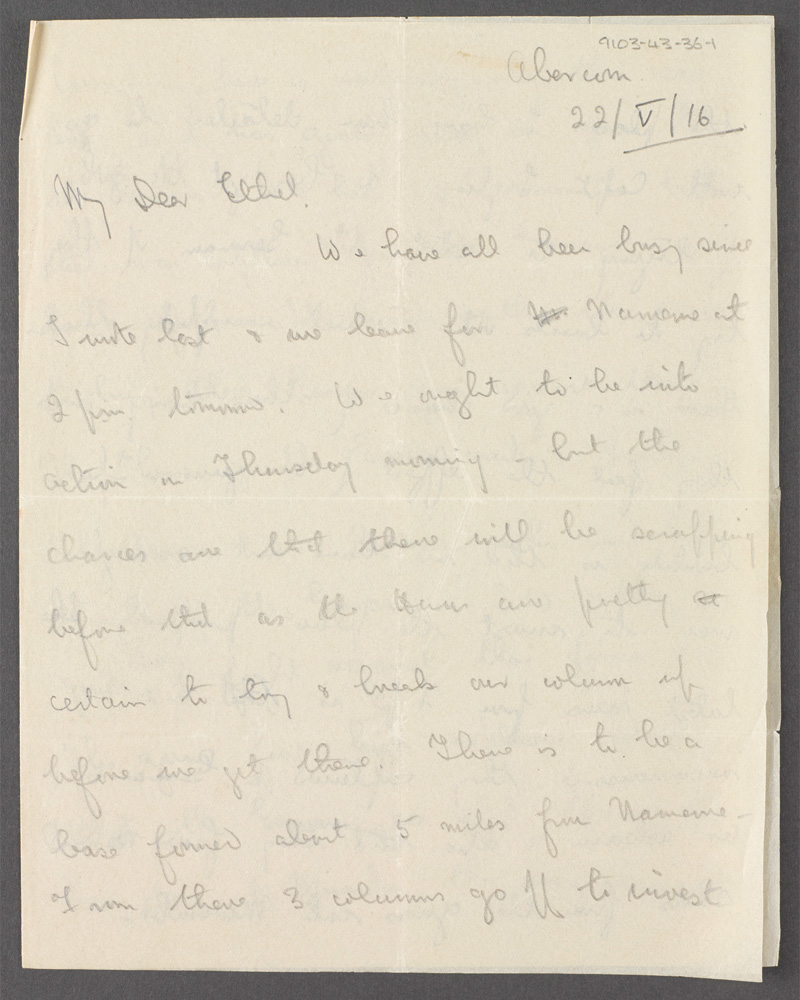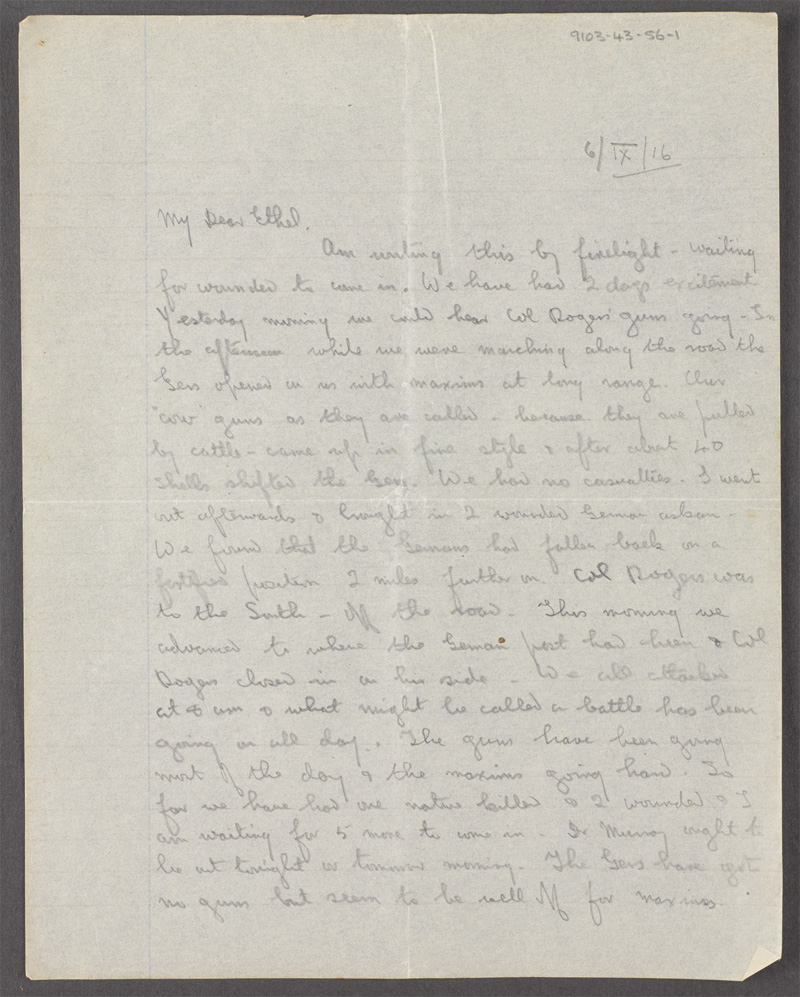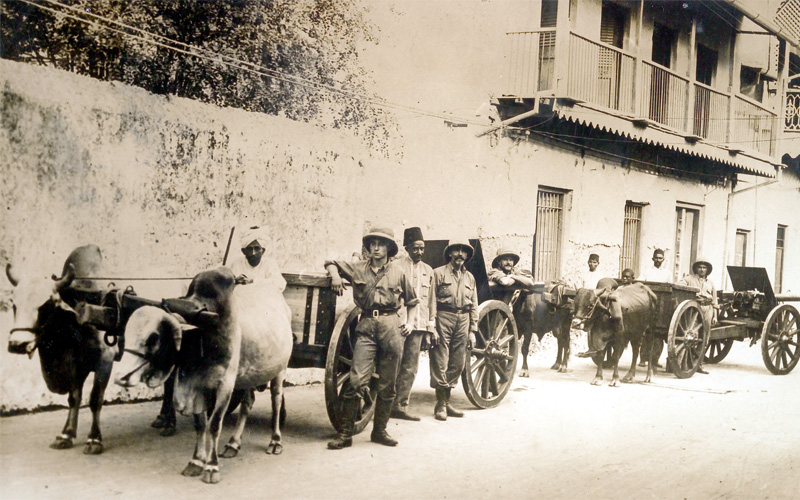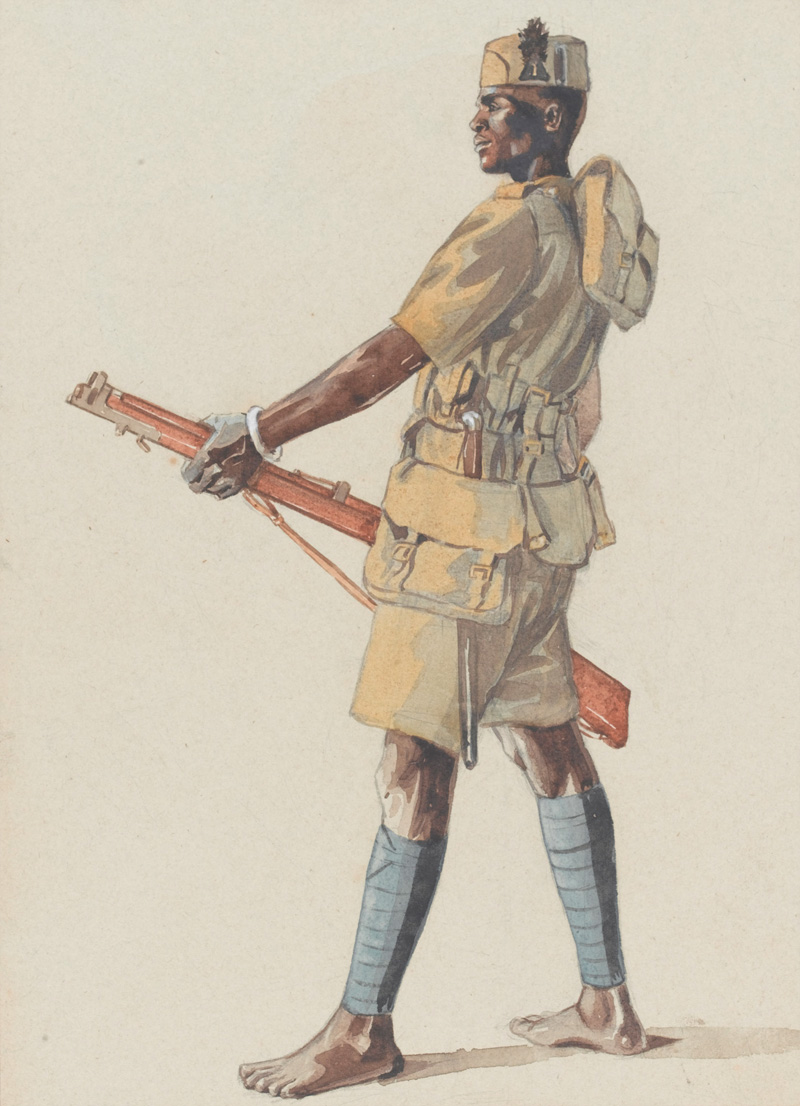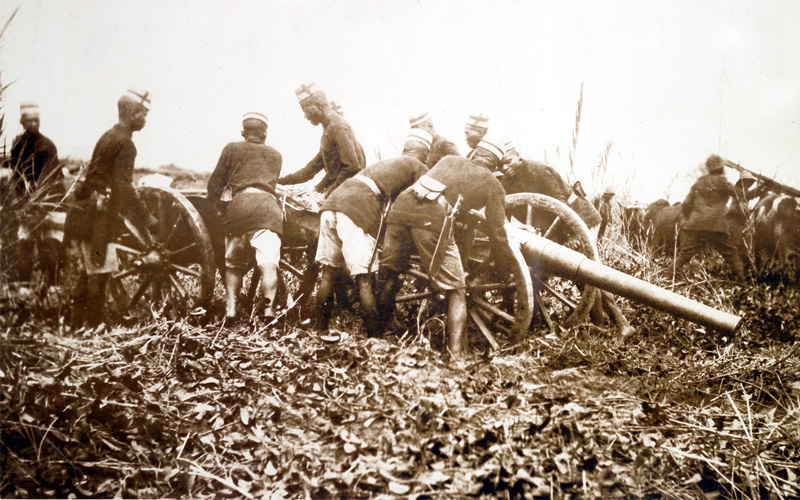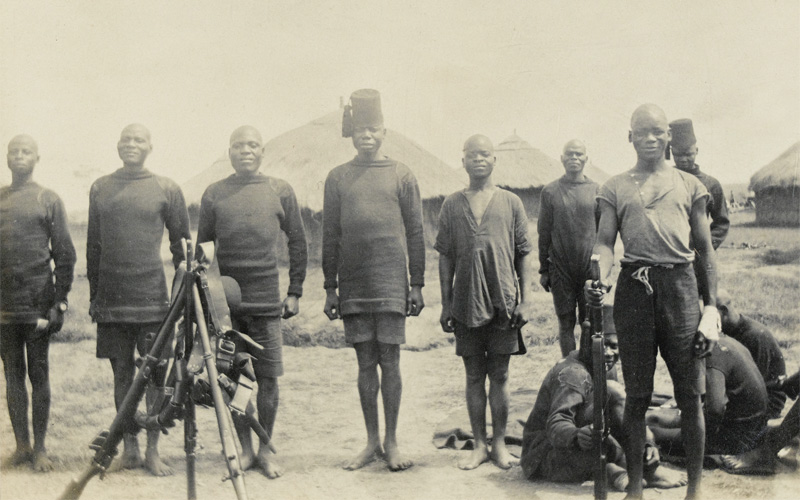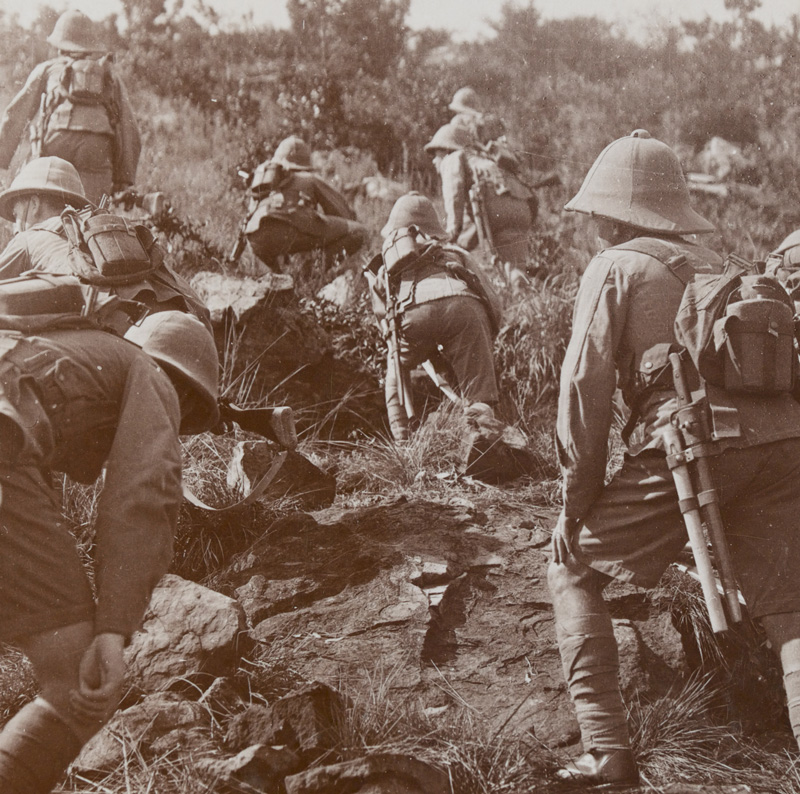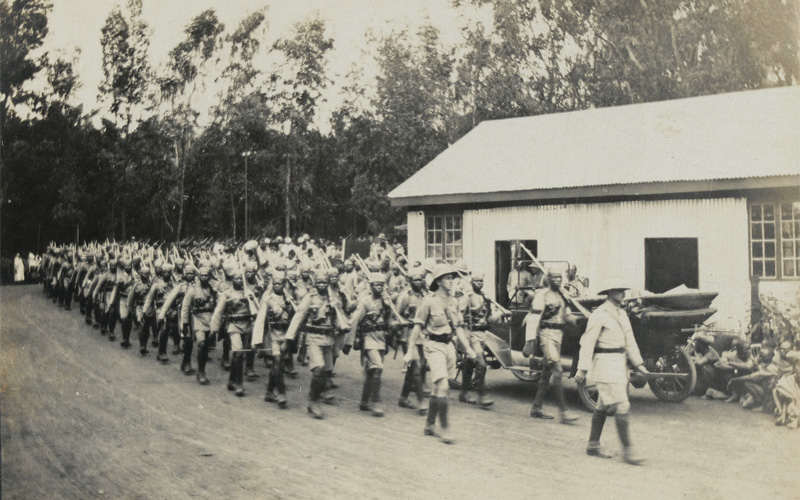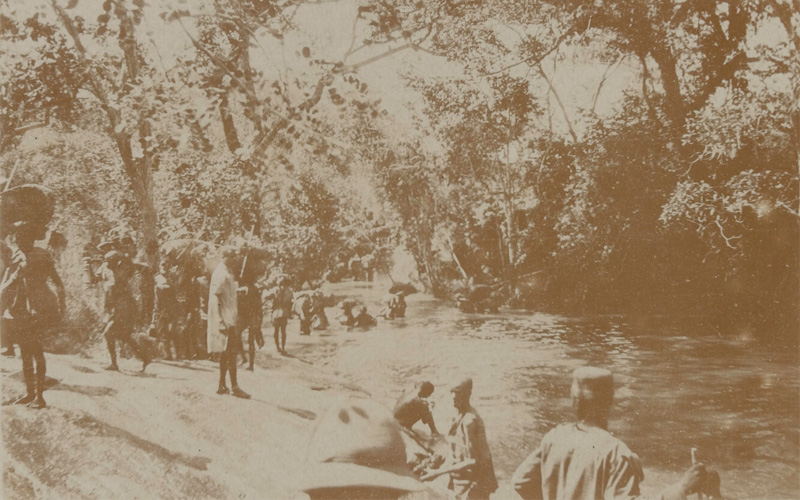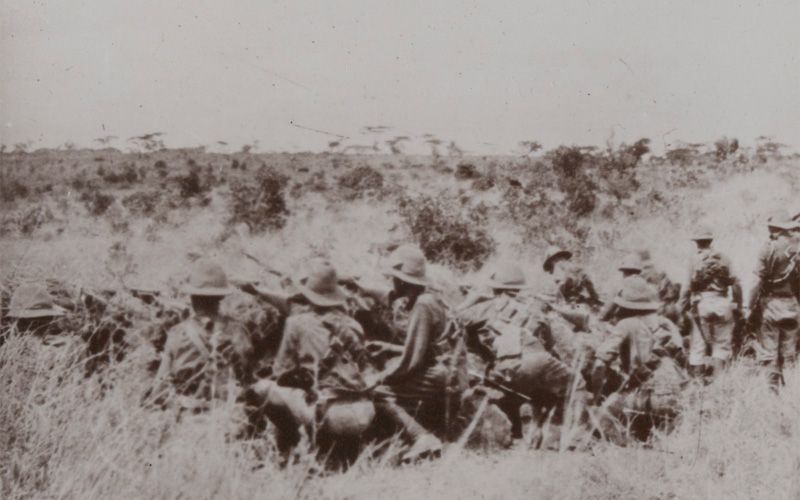Letters from medical officer Captain Alexander Wallace in German East Africa to his fiancée in Scotland form an evocative account of the First World War’s longest campaign.
East Africa
On the outbreak of war in 1914, Colonel Paul von Lettow-Vorbeck was the commander of a small army in German East Africa (Tanzania, Burundi and Rwanda). He was determined to tie down as many Allied troops as he could in the region to prevent them from being deployed elsewhere.
During a four-year guerrilla campaign he ran rings around his enemies. With an army that never numbered more than 14,000 men, comprising about 3,000 Germans and 11,000 askaris (African soldiers), he succeeded in occupying ten times that number of Allied troops.
These included Captain Alexander Wallace, a medical officer with the British South Africa Police, who joined a new British offensive in May 1916 that sought to reinvigorate the campaign. Wallace’s letters provide us with an evocative account of the East African conflict.
Defeat at Tanga
In August 1914 Lettow-Vorbeck had raided British positions around Mount Kiliminjaro and Lake Victoria in British East Africa (Kenya). In response, a British-Indian force under Major-General Arthur Aitken landed near the German East African port of Tanga on 3 November 1914. Aitken made no attempt at concealing his plans and Lettow-Vorbeck was given time to reinforce his defences.
When they came under fire, Aitken’s poorly-trained Indian troops panicked and ran. Although they were outnumbered, the Germans counter-attacked. Aitken’s troops were driven back to their boats, where they re-embarked on 5 November.
At a cost of 150 casualties, Lettow-Vorbeck had inflicted 850 casualties and captured hundreds of rifles, some machine guns, and 600,000 rounds of ammunition. The supplies left behind helped equip his army for the next year.
Raids
Britain commanded the sea and was able to send reinforcements. Lettow-Vorbeck, heavily outnumbered and with limited resources, switched to a guerrilla campaign, mounting raids in Kenya and Northern Rhodesia (Zambia).
At the same time, the German cruiser ‘Königsberg’ attacked Allied shipping off the coast. She was eventually sunk in July 1915.
New offensive
In March 1916, General Jan Smuts assumed command of the Allied forces. He brought with him South African troops who were now available following the conquest of German South-West Africa. A large Carrier Corps of African porters carried supplies for Smuts into the interior, much of which lacked railways or roads.
In May 1916 Smuts attacked from the north out of Kenya, while troops from the Belgian Congo (part of Democratic Republic of the Congo) advanced from the west. A column, under the command of Brigadier General Edward Northey, also advanced from Northern Rhodesia (Zambia) in the south west on 29 May. It was accompanied by Wallace’s company of the British South Africa Police.
Northey started his attack by investing Namema on the German side of the frontier near Abercorn (Mbala). Wallace outlined his concerns at the start of the operation:
‘The likelihood is that we have not enough men to invest the place properly [but] we have got a mountain battery that was captured from the Germans in South West Africa. It seems rather like nemesis to bring these guns against them. We have got the German mules and drivers who are Hereros who were bitter enemies of the Germans in SW [Africa] and they are keen to fight against their former masters. The guns fire high explosive shells… I do hope we are successful and haven’t very many casualties. The carriers require a bit of thinking about, if the Germans get in amongst them with a maxim they will bolt for a certainty and we shall be stranded… Everybody seems a bit excited.’
Under siege
Namema was captured after a short siege. Wallace described the conditions:
‘We have been investing this place for 5 days and are all hopeful… We have lost 4 white men and 3 wounded, all on my side of the fort. They were an advanced post and were surprised at dawn. It is mostly night work here which is trying. We have captured a German officer, very badly shot, and have killed some natives but numbers are uncertain. The Germans’ main position is on a hill but they have lots of small positions half way down all around. Their redoubts are built in between huge rocks and our guns can’t make much impression and we haven’t enough men to invest the place properly. However, with decent luck we ought to get them. We are trying to cut their water supply. This is certainly an experience. Haven’t had any clothes off since I left Abercorn. We live in dug outs and are quite comfortable… There is continual rifle fire all night here. We think there are 20 Germans and 200 askaris inside… Still to make certain the Germans don’t break through we ought to have 500 more men… Our men are all doing well and we are quite hopeful of the result. I never dreamt we should have this sort of warfare here… We get lots of queer food (beans etc) which we raid from the surrounding villages – the inhabitants having all cleared out.’
Unfortunately, most of the Germans got out of Namema in the night.
‘They cleared out through our lines and it wasn’t too pleasant. We got about 35 of them including dead wounded and captured. We made after them but didn’t get near them. We then made for Bismarckburg on Lake Tanganyika where we now are. Had a fight on the way, we had one askari killed. When we got here there was a mix up and a small party of ours came right in as they thought the Germans had surrendered. They had 5 Europeans wounded… The Germans made off by boat during the night.’
Wallace’s column pursued the Germans east to Iringa, which was reached in late August 1916.
Meanwhile, Smuts had captured the railway line from Dar es Salaam to Morogoro and Dodoma. Despite this, Lettow-Vorbeck always managed to disengage his forces before they were overwhelmed.
Bush fight
The Germans facing Northey’s troops moved south from Iringa towards the Ruhudje River, fighting a succession of rearguard actions. Wallace described a typical period of bush skirmishing:
‘In the afternoon while we were marching along the road the Germans opened on us with maxims at long range. Our “cow” guns as they are called – because they are pulled by cattle – came up in fine style and after about 40 shells shifted the Germans… I went out afterwards and brought in two wounded German askaris. We found that the Germans had fallen back on a fortified position two miles further on… We attacked at 8am and a battle has been going on all day and the maxims going hard. So far we have had one native killed and two wounded and I am waiting for five more to come in… The Germans have got no guns but seem to be well off for maxims.’
‘[The next day] we could hear our men letting off rifle grenades in the German position and as there was no reply we knew that they had cleared out… We found that they had only moved on about a mile so there was another all day fight. The country here is so mountainous that it is very easy for the Germans to leave a small rearguard to hold us up… The scenery is magnificent. Huge tree ferns all along the valleys and the hills covered with thick bush and bracken which you can’t get through without cutting down… After dressing the previous days wounded I left them in the old German position and went up to where our guns were shelling… Altogether in these three days scrapping we have had about 40 casualties… I believe the next 15 miles are very hilly so if the Germans continue to hold us up our progress may be very slow. The last three days have been pretty strenuous and I shall be glad of a rest.’
‘Having got the wounded away I rejoined the column. I found they had only gone two miles and were being held up by the Germans in the hills. Colonels Rogers and Murray thought the only thing to be done was to try and get round the Germans so at 6pm our column went out to do this. I can honestly say it was the worst night I have ever had in my life. It was bitterly cold and we marched through a succession of swamps… and pushed on up a steep pass through the mountains. Our men had just got to the top when they were fired on and for a time there was a regular duel… We had two men hit. We were rather lucky. The Germans must have got news of our flanking movement in the morning and rushed a force out to stop us. If they had got to the head of the pass a little sooner we would never have got up. The country here is simply a succession of hills. In the afternoon we pushed on another two miles, the Germans trying to stop us. We had to lie down every now and again when they were firing. Our scouts are out trying to find the whereabouts of the enemy… We then went on another four miles and got to a small mission flying a Red Cross flag. In it we found 15 Germans and 34 askaris, most of them sick, only a few wounded… All the Germans said they were tired of the war but that they were going to hold out until the very end. Most were from the crew of the Konigsberg… It is no good trying to prophesise about the end of this war – it seems as far off as ever.’
Harsh environment
Wallace’s column pursued the Germans down to the plains, where the heat was intense.
‘The difference is very marked compared with the climate up amongst the hills… It would be pretty dreadful if we were stuck in these malarial swamps during the rainy season. We are on the Kilombero River which flows into the Rufigi… The grass is very long and thick and we have to keep to the native paths. We shall all be very glad to see the last of it’.
Many troops suffered from the climate and tropical diseases. One unit, the 9th South African Infantry, began the campaign with 1,135 men in February 1916, but by October was down to 116, having hardly engaged the enemy.
For every man the Allies lost in battle, a further 30 were lost through sickness. Lettow-Vorbeck’s askaris, on the other hand, were more resistant to local diseases.
German counter-attack
At the end of October 1916 the Germans took the offensive. They threatened the British lines of communication between Kisinga and Iringa, cutting off Wallace’s column, before moving on Lupembe.
Wallace described the subsequent fighting:
‘Well the critical situation is over and our people gave the Germans something they will not forget about yesterday. [They] were holding the main road… There was one continuous roar of maxim and rifle fire for about an hour and a half… we then rushed their picquets. Our men went up at full speed, it was fine to see them… It was very difficult to see their position – it was hidden amongst the trees… It is very difficult to keep natives from banging away wildly. The Germans had maxims and whenever any of our men showed themselves on the skyline they let rip… We killed or captured about 150 of the enemy and got a field gun and five maxims. The wounded are just coming in. I believe the Rhodesians made a bayonet charge at dawn which settled things, but we have had some good men killed. A fine fellow called Judson, one of the scouts, charged right into a maxim and fell riddled with bullets… The Germans seem to be a plucky lot. There was a white man on each maxim and they were all bayoneted at their guns… The German askari were Nubians whom our men said were wonderful fighters.’
Several days later, Wallace’s unit engaged the Germans again near Lupembe:
‘We moved at dawn, proceeding slowly through the bush. We had only gone a few hundred yards when our scouts suddenly came on the Germans… Their main body opened out and came for us. There was a lot of firing for a bit… We had rather a rush to get away. The bullets were coming rather close… The hospital contingent went back a bit (not very slowly I can tell you) to get into a shallow depression. Our maxims got into action very quickly. While we were lying in our hole some Germans, who had probably been a picquet, got behind us and we felt rather uncomfortable until some of our men dropped back behind us. The fight went on for two hours and ended in the rout of the Germans… We buried 45 Germans and next morning they sent in a white flag saying they were leaving 40 wounded for us. Our casualties were under 30. Have had 60 wounded here and it has simply been a case of rushing from daybreak to sunset… I am getting them evacuated tomorrow. There are some very bad cases.’
Africans take over
At this time Smuts began to withdraw many of his South African, Rhodesian, and Indian troops and replace them with Africans from the King’s African Rifles, Gold Coast and Nigerian Regiments, who were more resistant to the climate and local diseases. By November 1918 the ‘British Army’ was mainly composed of African soldiers.
Final moves
By the end of 1916 the Germans were confined to the southern part of German East Africa. Early in 1917 new moves were made against Lettow-Vorbeck from Kenya, Nyasaland (Malawi) and the Belgian Congo (part of Democratic Republic of the Congo). His forces divided into three groups. Two of them managed to escape the offensives but the third, of around 5,000 men, was forced to surrender.
As the British closed in, Lettow-Vorbeck crossed south into the Portuguese colony of Mozambique. Small detachments of Germans attempted to join him there and Wallace’s column continued to pursue these for the remainder of the war, engaging in a series of skirmishes. Both sides were continually hampered by logistical problems and food shortages. Medical provisions were basic:
‘I got 41 wounded off yesterday, but still have 20 serious cases, mostly askaris. Their wounds are all very septic and it takes a long time to dress them. I hope to get the others off in a few days. There is difficulty in getting carriers for them… This is rather a filthy camp [and] the flies are simply swarming. There are also a lot of mosquitoes’.
Wallace was later Mentioned in Despatches and awarded the Military Cross for his care of the wounded during the fighting at Mpepo in September 1917. Of the 70 men he treated, 67 survived.
Surrender
As the British closed in, groups of Germans began to give themselves up. Wallace encountered some near Mahenge.
‘On the 26th the unexpected happened… I saw a man riding up waving his hat. I waved mine back and he waved again so I knew what he intended. Sixty Germans with 250 askari then surrendered… Many were wounded and sick… Their doctor was really a decent fellow. In fact most of the Germans seem pretty decent men. Everybody talks very highly about the way they have behaved. They have treated all their prisoners very well.’
Lettow-Vorbeck however was still raiding in 1918 when he learned of the Armistice, reputedly from a British prisoner. On 25 November 1918, he surrendered his unbeaten force, now reduced to about 1,500 men, to the British in Northern Rhodesia (Zambia).
Cost
During the campaign the British and Empire forces lost over 10,000 men. German losses were about 2,000. East Africans suffered the most. One estimate is that around 100,000 carriers and camp followers died on both sides. There were also civilian casualties.
‘There will be a lot of starvation… The Belgians told us that last year in the Rwanda country – between Lakes Tanganyika and Nyasa – 20,000 natives died of starvation. War is a sad thing for the native population. The troops occupy the country for a bit, take what food there is leaving nothing for the natives.’
Biography
Alexander Frank Wallace (1885-1954) was born on 7 October 1885 in Aberdeen, the son of John Wallace a wine merchant, and his wife Elsie. He had a younger sister and two younger brothers. The family lived at 53 George Street and then 139 Hardgate.
Known as ‘Sandy’, Alexander was educated at Robert Gordon’s College and the University of Aberdeen, where he qualified as a bachelor of medicine in 1906.
Wallace then intended to move to New Zealand, but en route his vessel stopped off at Port Elizabeth in South Africa. He decided to stay there and worked in several hospitals before moving to Northern Rhodesia (Zambia).
In August 1909 he was appointed medical officer at the British South Africa Company’s Fort Jameson (Chipata). Six months later he transferred to Broken Hill (Kabwe), where he treated patients with malaria, blackwater fever and sleeping sickness, an illness he made a special study of for his doctorate, which was awarded in 1913.
Wallace was engaged to Ethel that year and intended to return to his sweetheart in Scotland, but the war intervened. He joined ‘A’ Company of the British South Africa Police in August 1915, and spent the early part of the war securing the border between Rhodesia and German East Africa. In May 1916 he joined the new British offensive.
Wallace was granted sick leave in Spring 1918. He wrote: ‘I can’t quite convince myself that I am on my way home yet. It seems too good to be true.’ (Letter from Captain Alfred Wallace to his fiancée Ethel, 10 March 1918, NAM. 1991-03-43-139). On returning to Scotland he married Ethel. They later had a son and a daughter.
After recovering, Wallace briefly studied medicine in Dublin before returning to Broken Hill with his wife. He remained there as medical officer until forced to retire in 1932 due to ill health.
Wallace was appointed medical officer at Trinity College in Glenalmond (now Glenalmond College). He died at Perth on 13 December 1954 from cancer.
Explore further
- Article: Other Soldier Stories
Explore the map for similar stories
Captain Alexander Wallace - Aberdeen
 First World War in Focus
First World War in Focus

